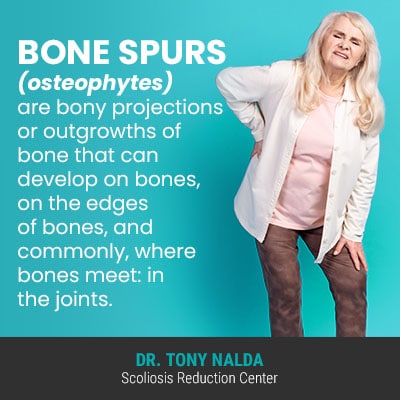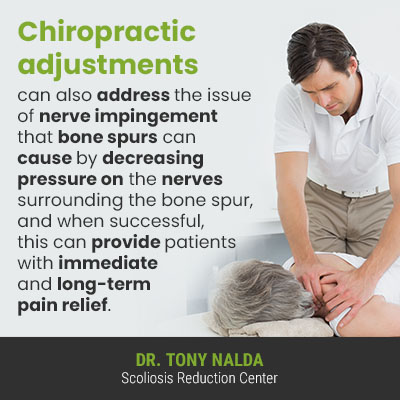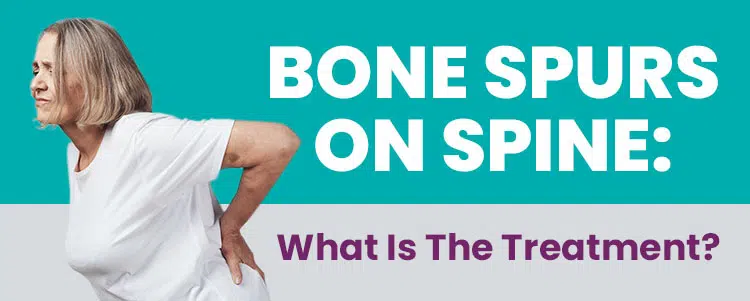As such a complex structure, the spine is made up of many important moveable parts and is susceptible to a variety of spinal conditions. Bone spurs develop for different reasons, but most often, it’s due to joint damage. Treatment plans for bone spurs on the spine need to be customized to address key patient/condition variables.
Bone spurs are bony projections that develop along bone edges and where bones meet in the joints and form on the spine. Treatment needs for bone spurs on the spine will be case-specific based on the underlying cause, severity, symptoms, and location.
Before getting to the specifics of bone spurs, let’s explore some basic spinal anatomy for a better understanding of how bone spurs on the spine can affect overall spinal health and function.
Basic Anatomy of the Spine
There are three main spinal sections: cervical (neck), thoracic (middle/upper back), and lumbar (lower back).
Each section has its own unique curvature type, and the integrity of each section is dependent upon the others.
The spine is made up of vertebrae (bones) stacked on top of one another in a straight and neutral alignment.
In order for the spine to function optimally, it needs to maintain its natural curves and alignment.
The vertebrae are separated by intervertebral discs, which give the spine structure, provide cushioning between adjacent vertebrae, work together to facilitate flexible movement and range of motion (ROM), and act as the spine’s shock absorbers.
Each vertebra has two pairs of facet joints, one pair on the top to connect to the vertebra above and one pair on the bottom to connect to the vertebra below.
In addition to being the body’s main structure supporting the weight of the trunk, providing balance and the ability to remain upright, the spine also allows for the absorption and distribution of mechanical stress incurred during movement and works in tandem with the brain to form the central nervous system (CNS).
The vertebrae of the spine have a hollow opening in their centers, forming a type of tunnel through which pairs of spinal nerves pass and project to different areas of the body.
In order for the spinal nerves to perform (send and receive important signals for brain-body communication), they need space.
So now that we have a basic understanding of the spine’s main structures and how they impact overall spinal health, let’s talk specifically about bone spurs that can develop in the spine.
What are Bone Spurs?

“Bone spurs (osteophytes) are bony projections or outgrowths of bone that can develop on bones, on the edges of bones, and commonly, where bones meet: in the joints.”
Bone spurs can develop in various joints of the body, including the joints of the spine.
Symptoms of Bone Spurs
Many patients with bone spurs don’t experience noticeable symptoms and find out about them by accident when being X-rayed for another condition.
In some cases, however, bone spurs can cause pain and a decreased range of motion in the affected joints.
Specific symptoms will depend on factors such as patient age, cause, severity, and location.
For example, lower back bone spurs on the spine will mean treatment efforts are concentrated on the lumbar spine, and symptoms are likely to be most intense in the lower body.
Bone spurs that develop in a knee can make it difficult and painful to extend and bend the leg fully.
Bones spurs that develop in the hip can make it painful to move the hip, reduce the range of motion, and related discomfort can also be felt in the knee.
When bone spurs form on the vertebrae of the spine, they can cause a loss of space for the spinal cord, which houses important spinal nerves within.
If a bone spur has projected into the spaces within the spinal cord, it can become compressed/impinged, along with corresponding nerve roots, and this can cause radicular pain felt anywhere along the affected nerve’s pathway, weakness, or numbness felt in the arms and legs.
So, how do spinal bone spurs actually impact overall spinal health and function, and what causes them to develop?
What Causes Spinal Bone Spurs?
Bone spurs are commonly diagnosed through a combination of physical assessment and X-ray imaging of affected joints/bones.
Once a diagnosis of bone spurs on the spine has been given, their severity, cause, and location factor into the type of symptoms, if any, a patient will experience, and these factors will be the driving force of treatment.
Once the underlying cause of spinal bone spurs is determined, a customized treatment plan can be crafted that addresses important patient/condition variables.
The most common cause of spinal bone spurs is joint damage caused by arthritis of the spine: osteoarthritis.
Osteoarthritis is the most common type of arthritis and can also be called degenerative joint disease and/or wear-and-tear arthritis.
Osteoarthritis of the spine is common in people 50+ years of age and is more prevalent in women due to changes in hormones and bone density related to menopause.
When the cartilage within the spine’s facet joints starts to erode and break down, the underlying bone (vertebra) experiences degenerative changes, and the facet joints become vulnerable to injury and inflammation.
When the joints of the spine are affected, its structure is compromised, and the spine’s ability to function optimally and provide enough space for the spinal nerves to also function within is compromised.
In addition, with the weakened structural elements, the spine’s ability to maintain its natural curvatures and alignment is disrupted and can lead to the development of additional spinal conditions like scoliosis.
So, what is the treatment for bone spurs on the spine?
Bone Spurs on Spine Treatment
While there are surgical options for removing bone spurs on the spine, like all surgical procedures, they come with their share of risks and potential complications.
While each case is different, for those whose spinal bone spurs are causing pain, over-the-counter medication can help manage it and reduce related joint inflammation.
However, medications are only addressing pain as a symptom of bone spurs, but not the actual underlying cause of the bone spurs on the spine. Pain medication comes with side effects and is not a permanent solution; the goal is to use pain medications for temporary or short-term pain relief.
Steroid injections can be injected into areas affected by inflammation and causing pain, particularly when injections are guided by ultrasound for precise locations.
Rest and activity modification can also be a facet of treatment, and physical therapy can be helpful at working towards joint strengthening and increasing the range of motion in the area.
Therapies such as low-level laser therapy (LLLT) can also be helpful in addressing pain, inflammation, and soft-tissue mobilization.
Physical therapy and exercises for spinal bone spurs can help to improve the range of motion and strength in the spine, and this can help address bone spurs by taking pressure off affected spinal segments, thereby reducing complications of spinal bone spurs.
For patients carrying excess weight, weight loss can be a helpful component of treatment by reducing the amount of weight the spine has to support, taking pressure off the spine and its parts, and reducing friction between the vertebral facet joints.
Chiropractic care is another component of treatment for spinal bone spurs, and while a chiropractor can’t remove a bone spur, if it’s causing symptoms like pain, a chiropractor has a variety of techniques that can help with repositioning affected vertebrae and improving the health of a bone spur’s surroundings and making improvements that way.
Often, chiropractic care will focus on restoring the spine’s natural curves and alignment, as this means a spine that is functioning optimally, and working towards increasing flexibility of the spine and/or joint can also help take pressure off the affected part/area.
In some cases, improving mobility in the spine and joint, and restoring healthy curves and alignment through chiropractic adjustments can address the underlying problem and result in the body absorbing the bone spur.

Chiropractic adjustments can also address the issue of nerve impingement that bone spurs can cause by decreasing pressure on the nerves surrounding the bone spur, and when successful, this can provide patients with immediate and long-term pain relief.
Conclusion
Bone spurs are extra bony growths that can develop on bones, on the edges of bones, and most commonly, where bones meet: in the joints.
When bone spurs on the spine develop, they are most commonly caused by arthritis of the spine (osteoarthritis), and this involves a loss of cartilage that protects the joints and enables the smooth gliding motion of one joint against another during movement.
Once the spine starts to degenerate, it can experience structural changes that impact the spine’s ability to maintain its natural curves and alignment, and this disrupts the biomechanics of the entire spine.
While not all bone spurs are painful, with some being asymptomatic, once symptoms become noticeable, treatment is needed to restore as much function in the area as possible and prevent further damage and nerve compression.
Here at the Scoliosis Reduction Center®, I specialize in non-surgical treatment options for a variety of spinal conditions, bone spurs on the spine included, and once the underlying cause is determined, I integrate different treatment disciplines for the best results: lifestyle\activity modification, rest, medications (when needed), condition-specific physical therapy, and chiropractic care.





